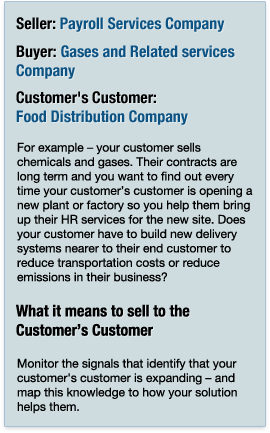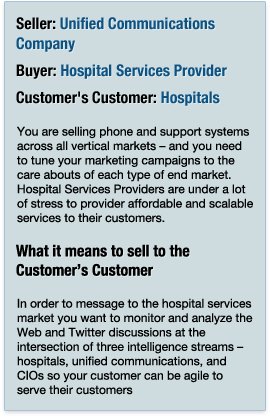The world is slowly climbing out of the great recession as companies around the world begin to increase investment and hiring. But for B2B sales teams looking to recapture growth during these early days, it's critical to understand who's really paying their bills and keeping the lights on -- and guess what? It's not your customer ... it's your customer's customer. And if your sales team doesn't deeply understand the business problems of these folks, then you'll lose to competitors who do.
Before I get into the reasons why this is, consider some of the big, underlying changes happening in the market today. As companies start growing and investing again they are spending money, but they have fewer people than they had before. This means less time to accomplish key objectives and an even stronger focus on developing efficient strategies and processes to drive revenue growth ahead of the competition. As a result, they are changing the way they do business, innovating in the vertical integration of their product lines and socializing their go-to-market, because if they can innovate and out-execute the competition in the way they serve their customers they can gain more market share as spending comes back.

To accomplish this, large companies are now talking about "business transformation" in their sales teams, "cultural transformation" in how they interface with their customers, and building a "social business" as a new way to look at their internal collaboration process. With all these trends, the end objective is the same: How to better solve their customer's business problem and so gain market share.
And so how do you solve your customer's problem? Well like you, their challenge is revenue, profit and market share. So when your sales team understands their customer's customer -- and the business dynamics, competition and growth opportunities that their customer has -- magic happens.
Here are the top 5 reasons:
1. You can focus on the customer's business problem, not your products
It's a cliché, but a true one: your customers don't buy products, they buy solutions. But you can't sell them a true solution unless you know what problem they are trying to solve, and understanding their customers will give you the insight you need to hold a useful conversation with your customer.
If you pitch product you become a tactical vendor; if you can discuss their customer and how they are serving their customer you become a member of your customer's team. For example, is their customer driving price down on them -- and so is your opportunity to help them take cost out of their operating expenses? Or are they focused on revenue and end user growth -- and can your solution help your customer reduce their time to market?
Understanding the customer's problem is sales 101, right? But it is surprising how many sales people still pitch product. It's essential you provide your sales team with the intelligence and systems to stay on top of the customer's ever changing end-business problem (see #5).

2. You can align your solutions with your customer's evolving needs.
While the customer is always right, the reality is they may not actually be asking for the right solution. Maybe this is because they lack specific knowledge of the options available, they have budget concerns or because internal politics are at work.
But consider a recent study by the Corporate Executive Board that says that buyers don't contact vendors until they are, on average, more than half-way through the buying process. This means that by the time you are contacted as a vendor (if you are contacted!), it may be too late in the process to help your customer identify a better solution mix for their needs.
If, on the other hand, you truly understand your customer's problems and challenges because you have studied their customer, and you are engaged with helping them meet these needs, then you can design specific solutions to meet the needs of their evolving business -- before your competitors are asked to get involved.
3. You can design your marketing programs to address what you customer cares about
It is possible today to understand what an end buyer cares about in ways that have simply not been possible before. The Web and social media create an unprecedented level of transparency into a market, and can show you what's top-of-mind at your end B2B customer. And it's a noisy, Big Data world which means you need technology to do it.
There are millions of articles, blog posts and Tweets posted on the Web every day, but using newly emerging semantic analytics you can monitor intelligence in a very precise way. You can now analyze the intersection of three views of your customer's business and so understand what the top issues are for them. When you can see the intersection of:
- the vertical market you are targeting
- the business line you are selling and
- the role which is going to buy your product (e.g. CIO, EVP Sales et al)
...you can then target your marketing campaigns to speak to the specific issues the companies in a vertical market care about. By monitoring what your target market is talking about you can ensure your messaging -- and your value -- speaks to their top-of-mind problems.
4. You find new customers.
Many businesses have triggers that drive new customer opportunity. It could be generic management changes, like a new executive being hired, but just as often businesses are driven by precise, industry-specific changes that create new opportunity for you. Is there a government RFP released that impacts your customer's business? Has a competitor created a dislocation in your customer's end market? Does your customer need to execute M&A flawlessly to execute their strategy? When you understand your customer's customer you can monitor the very specific events and changes in their business that signal an opportunity for you.
Automatically alerting your sales person on their iPad or mobile phone each time there is an industry-specific event which impacts their customer will win you new business.

5. The majority of your sales team can be as effective as the top 5%.
Most sales people don't like to do research, but the top 5% -- your rainmakers -- do. They already do the work to understand their customer's customer, they plan out a campaign, they do research every morning before they place any calls. They study the customer and understand the customer's business and many will spend 1-2 hours a day doing it. When you provide Enterprise Customer Intelligence to your sales team and teach them the Why and How needed to focus on their customer's customer, you'll raise every team member's productivity. And when you integrate the intelligence into the CRM and social enterprise systems they are already using, there are No More Excuses.
Your customer's customer is the real revenue engine behind your business, and the B2B companies who truly believe this, and are investing in the systems for their sales teams, are the ones who are already pulling ahead of the competition, even in this lukewarm recovery.